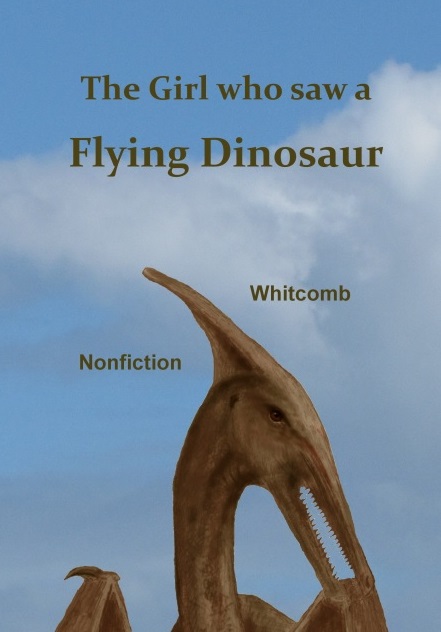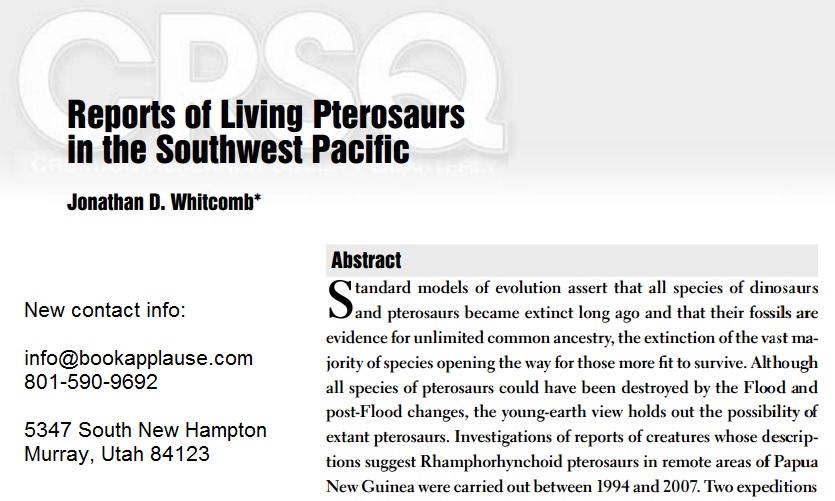Scientific Paper About Living Pterosaurs
By the cryptozoology author Jonathan Whitcomb
Introduction
My “Reports of Living Pterosaurs in the Southwest Pacific” was published in the Winter-2009 issue of the Creation Research Society Quarterly (Volume 45, #3). I now refer to the last four pages of this scientific paper, with links to images of those pages.
But first be aware that much of my scientific paper is about two expeditions on Umboi Island, Papua New Guinea, in 2004. I led the first expedition, with my native interpreter Luke Paina; David Woetzel and Garth Guessman were assisted, a few weeks later, by the native interpreter Jacob Kepas.
After those two expeditions on that tropical island, I concluded that the ropen of Umboi is a living pterosaur, similar in general shape to a Sordes pilosus but much larger than fossils of that kind of Rhamphorhynchoid. In addition, the ropen has a long horn-like head crest.
Page 209 of this Journal of Science
This refers briefly to the sighting by native Jonathan Ragu on the coast of Umboi Island. Much on this page, however, is about the possibility that the ropen is a modern living Rhamphorhynchoid pterosaur.
Page 210, with this Scientific Paper (11th page of the article itself)
It examines the two interpretations, one by Whitcomb and the other by Woetzel, for what kind of Rhamphorhynchoid the ropen may be: “Dimorphodon or Sordes?” This page also examines eyewitness reliability, and this subject continues into the next page.
Page 211 of this issue of Creation Research Society Quarterly
One section on this page is “Investigator Reliability.” Here’s how it begins:
A few critics have suggested that living-pterosaur investigators are dishonest . . . but to date have offered no evidence. From 1994 through early 2007, eight American creationists have traveled to PNG in eight expeditions (one to three Americans per expedition). These expeditions involved personal financial sacrifice. . . .
Page 212 (or the 13th page of this scientific paper on living pterosaurs)
Here are the surnames of persons mentioned at the end of the article:
- Goertzen
- Kuban
- Naish
- Paiva
- Silcock
- Wellnhofer
- Whitcomb
- Woetzel
###
.
Scientific Paper on Extant Pterosaurs
Almost ten years ago, my scientific paper was published in the Creation Research Society Quarterly: “Reports of Living Pterosaurs in the Southwest Pacific.” It was in the Winter issue of 2009 . . . [refers to three pages from that journal of science]
.
A biology professor in Minnesota wrote a blog post, the other week, blasting my research and investigations into sighting reports of apparent pterosaurs (AKA pterodactyls). Most of his declarations about my intentions, however, were false. His mistake about my purposes in writing that page on lds-nonfiction-dot-com, however, was interesting to me; I was actually writing to members of The Church of Jesus Christ of Latter-day Saints who might enjoy reading my most recent book, Searching for Ropens and Finding God . . .
.
Skeptics have often suggested two explanations for sightings of pterosaurs: hoaxes and misidentifications. Let’s use scientific reasoning by examining the most recent results of data compilations and analysis, for information obtained from eyewitnesses, in particular regarding the possibility of major hoax involvement.
.
“Ropen” deleted on Wikipedia (English)
The “ropen” page on Wikipedia, at one time, had many paragraphs, delighting some cryptozoologists but annoying some skeptics. One biology professor in Minnesota, in particular, detested the many web pages he saw that supported belief in modern living pterosaurs, including the long-tailed ropen. . . . Some critics of modern-pterosaur investigations find fault with imagined motivations of me and my associates, using that bulverism to avoid the real issue of whether or not all species of pterosaurs became extinct.
.
Science and the ropen of Papua New Guinea
The ropen is a long-tailed flying cryptid described as pterosaur-like and reported by eyewitnesses around the world, especially in North America and in the southwest Pacific (including Australia). The word “ropen” comes from Umboi Island, Papua New Guinea, where in the local language of Kovai it refers to a large nocturnal flying creature that briefly, on occasion on some nights, glows brightly.
.
Many species of pterosaurs have lived on this planet at some time in the past. What evidence is there that all of those species have become extinct? NONE!
.
***************************************************************************
Nonfiction book on living pterosaurs (for children)
The Girl who saw a Flying Dinosaur
This is a press release on this paperback book about non-extinct “pterodactyls.”
.
To report a sighting of a possible pterosaur, contact Whitcomb.
.
Top of the first page of the scientific paper by Whitcomb
.

